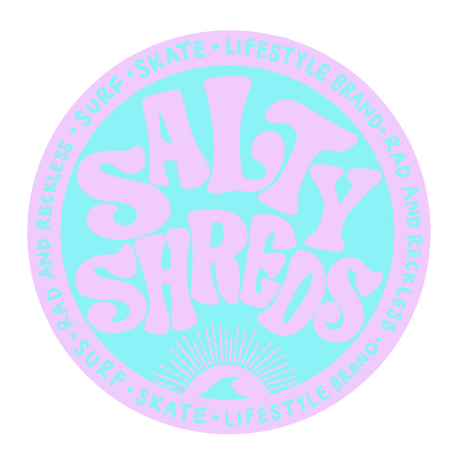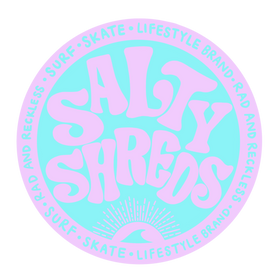Follow Salty Talk for More Radical Reads!
Why is my Surfboard Yellowing?
People age, and so do surfboards.
Just as our skin is often the first to show visual signs of getting older, so is the exterior skin of our surfboards, the once brilliant white epoxy or polyester turning a dull yellow from so much time spent under the shining sun.
If you surf enough, then a yellowing surfboard is unavoidable. But it's one of those things that isn't necessarily a 'bad' thing. If anything, it's a visual representation/metaphor of all those incredible memories you've created riding beautiful, fun waves session after session. The more yellow a surfboard, the more that means it has fulfilled its intended purpose!!!
That said, you might still wonder why your surfboard is yellowing and if there's anything you can do to prevent/reverse this common surfing occurrence. And I've got some insight!
What Causes Surfboard Yellowing?
A yellow surfboard is a sign of one thing: UV exposure (as well as the resulting heat). AKA, the fiberglass resin and underlying foam undergo a chemical reaction through long-term sun exposure, and that once brilliant white starts to lose its luster.
You're probably thinking: "But isn't it impossible to avoid the sun?".
Exactly. Each time we surf, we expose our boards and bodies to UV rays (hence the need for sunscreen!). That's why there's literally no avoiding a yellowing surfboard and why it's something the surf world has deemed normal.
It's also why surfboard shapers put a particular chemical into these resins that help negate the yellowing, and it takes a long time for a board to turn yellow. But still, you can't hide from the sun.
That said, you can still do plenty to prolong a surfboard from yellowing, and I've got a few tricks to reverse a bit of that surfboard sunburn once it does happen.
How to Prevent a Yellow Surfboard
Radical Swimwear + Womens Surf Clothes For all you Salty Shredders!
We all want our surfboards to look shiny and new, just like the day our feet first touched the wax. These strategies help you slow the surfboard yellowing process; overall, most are good surfboard care strategies regardless.
1. Practice Proper Surfboard Storage
Unfortunately, our surfboards spend more time where they are stored than they do in the ocean. When it comes to your surfboard's sleeping arrangements, store it entirely out of the sun. Like your favorite herbal medicines, a good rule of thumb for surfboard storage is "keep it stored in a cool, dry place."
That way, the only UV rays your board sees are those shining down during a surf sesh.
2. Traveling with Surfboards
Sure, you can slap some straps to the racks, toss the board on, and hit the road. But if you don't place your board in any form of protection, you've created a 'tan-while-you-drive' business for surfboards.
Always place the boards in a legitimate, safe travel board bag when traveling via car. First, you should never leave them exposed on the roof, anyway. Rocks from a tire ahead, a low-hanging branch, or anything between will ding the heck out of your board. And that's worse than just surfboard yellowing.
But talking about yellowing, a car's roof is hot and attracts intense sunshine. Board bags prevent yellowing while traveling, control temperature on the roof, and overall they're the best method for surf travel.
3. Don't Leave Your Board in the Car
Reflective windows and increased temperatures are a recipe for surfboard yellowing. Do your best to leave your board out of a hot car, as this hot box is a surfboard's worst enemy.
4. Fix Dings IMMEDIATELY
Notice the emphasis on immediately? That's because dings are the worst thing that can happen to your board. Not only does a ding expose the foam to potential water damage, but remember when I said that the exterior resin on your board protects it from the sun?
Your board's resin will eventually turn yellow, but it's way more durable than the foam below, able to withstand far more UV exposure. As soon as that foam is exposed to the sun, it is susceptible to faster, more intense yellowing. So if you notice a ding, let it dry away from the sun and fix it immediately to avoid all sorts of damage, including a yellow surfboard.
5. Don't Buy a White Surfboard
Nothing is more attractive than a classic, clean, bright white surfboard. That said, the white resin will turn yellow faster than most colors, and it's a smaller timeline until you notice its aging.
If you buy a colored surfboard, instead of turning yellow, UV exposure results in more of a dull fading. It's not as noticeable, and it doesn't look quite as bad as sickly yellow.
How to Make a Yellow Surfboard White Again
The good news is that there are strategies you can implement to turn a yellow surfboard white again!
1. An Extremely Gentle Sanding
One of the best, most effective ways to reverse surfboard yellowing is to sand away the top portion of resin exposed to the sun. You have to be super careful not to damage your board, so take your time and be gentle.
All you need is a red Scotch Brite pad (not the heavy duty) and an hour or so of your time, and you can make a yellow surfboard look brand new. Start by removing the surfboard wax and cleaning the deck, and slowly work your way around the entire board with small, light circles until the yellow skin is carefully peeled away.
2. Paint It!
Other than sanding the board with a Scotch Brite pad, there's no other way to reverse yellowing aside from painting right over the yellow itself!
Breathe new life into a surfboard by giving it a light paint job, and take advantage by adding your artistic, personalized touch to your board. Or if it's time to retire your board, use it as a blank canvas and hang it on the wall for some radical ocean-inspired artwork.
Does a Yellow Surfboard Perform Worse?
Surfboard yellowing is a sign of aging and sun exposure, so does that mean it will perform worse?
Overall, not really! But also sort of…
The yellowing itself doesn't affect how a board rides much, but it is a sign it's been in a lot of sun. Therefore its surface is weaker, softer, and more susceptible to dings. And if there IS one thing that hinders a board's performance, it's a big old ding, especially one that takes on water.
A yellow surfboard has plenty of life, and it takes a really, really long time before it begins affecting how it rides. But it is a sign it's getting older. So take with that what you will, and do all you can to prolong its lifetime with proper care and storage.


Comments
Gavin said:
Does showering your board with fresh water after you surf stop the board from going yellow too. If so does salt water cause the board to go yellow too.